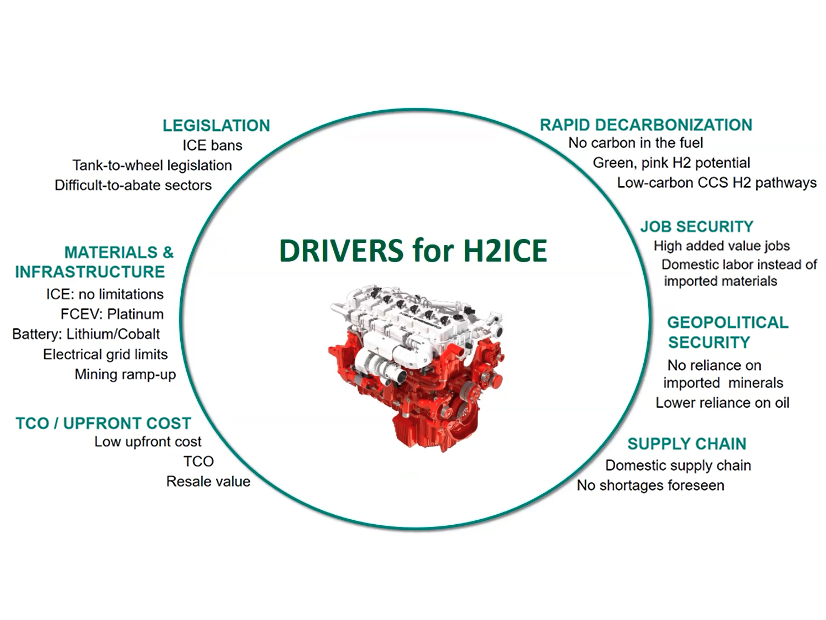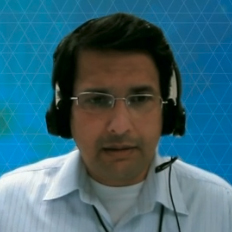
The race to clean up the nation’s transportation sector by ending its reliance on the internal combustion engine includes a dark horse that could be a contender as the best technology for heavy long-distance trucking: a hybrid diesel engine (H2ICE).
Modified to burn hydrogen, the H2ICE has become the focus of active research and development by engine builders globally. It has also garnered the interest of governments because such an engine could sharply and cheaply reduce carbon emissions within a decade.
In such an engine, the hydrogen replacing a large percentage of diesel fuel would produce more water vapor than carbon dioxide.
The U.S. Department of Energy’s Vehicle Technologies Office (VTO) has been focusing on the creation of diesel-hydrogen hybrids, and several federal laboratories are involved in research to develop the technology.
 The current industrial research and development efforts to convert diesel engines from an oil-based fuel to hydrogen is unprecedented. | DOE
The current industrial research and development efforts to convert diesel engines from an oil-based fuel to hydrogen is unprecedented. | DOE
“Hydrogen-fueled engines have several favorable attributes, including the use of existing engine platforms, which means we can use existing manufacturing infrastructure,” Gurpreet Singh, manager of the VTO’s Advanced Combustion Systems and Fuels Program, said in remarks opening a DOE webinar Wednesday focusing on H2ICE development.
H2ICE systems are also under development to replace conventional diesels in freight locomotives because existing fuel cells are inadequate for locomotive use and battery systems would be too expensive. Two federal labs are involved with locomotive products manufacturer Wabtec. (See Hydrogen-burning Locomotive Focus of New Federal Research.)
A massive deployment of H2ICE-powered Class 8 tractor-trailer trucks would also accelerate the development of a national hydrogen fueling system at existing truck stations throughout the interstate highway system.
 Gurpreet Singh, DOE | DOE
Gurpreet Singh, DOE | DOEThat hydrogen network would then be in place for fuel cell electric heavy trucks as they are developed, Singh said.
H2ICE offers something fuel cell electric systems or battery-electric systems currently cannot: engines that do not contain any imported or exotic rare-earth metals and are capable of producing a lot of power by combusting hydrogen that does not need to be pure, as it must be for use in a fuel cell.
H2ICE technology also inherits well developed industrial supply chains and a century of manufacturing expertise backed by already trained mechanics.
In contrast, fuel cells large enough to replace the 15-liter diesel engines in Class 8, over-the-road rigs have not been fully developed, and battery-electric heavy trucks, though being manufactured in small numbers, have two problems: battery weight that reduces total freight capacity, and the need for massive electric charging stations, reducing their current range.
Battery-electric trucks, from delivery vans to shorter-haul Class 8 rigs, are already in use or being tested. (See Electric Trucking, from Delivery Vans to Big Rigs, Are Coming and Report: Electric Heavy-duty Trucks Can Now Replace Some Diesels.) But moving from test fleets to replacing the estimated 2 million tractor trailers in the U.S. could easily take decades, and that has helped create the niche for H2ICE technology.
 Ales Srna, Sandia National laboratory | DOE
Ales Srna, Sandia National laboratory | DOE“Why bring another technology to the carbon-neutral portfolio? The reason is that the mixed scenario is likely the lowest-risk, fastest and most cost-effective pathway to carbon neutrality,” Ales Srna, an engineer at Sandia National Laboratories, said in opening the webinar.
He added that H2ICE technology could benefit early adopters because the engines could initially use blends of natural gas and hydrogen. And he argued that the technology could be retrofitted to some existing diesels as the hydrogen fuel injection systems continue to be developed.
Noting that fuel cell technology is more developed currently than hydrogen-diesel hybrid technology, Srna said H2ICE systems could arguably become more efficient and less costly to operate than fuel cell vehicles in severe service applications, such as excavating equipment in which the engine is under a constant heavy load.
Several current studies have concluded that fuel cells would be a better technology than H2ICE in “smaller, lower-power applications or where noise and emissions are key factors; for example, in urban environments,” he said. But in heavy-duty applications such as long-haul trucking, the H2ICE would be less costly than a fuel cell initially and a contender as less costly in total cost of ownership compared to a truck powered with a fuel cell.
Srna said federal legislation enacted to decarbonize the nation’s transportation system excluded more funding for H2ICE systems, unlike European programs, which allow for hydrogen combustion as a zero-emission technology. That appears already to have led to the development of extremely efficient, and clean-burning, H2ICE engines for heavy trucking in Europe, he said.
“Current emissions legislation [standards] is not a challenge for some prototypes and some demonstrators on the road,” he said of the early European hydrogen-diesel hybrids already being road tested. “And they may be compliant without any after [combustion] treatment, which significantly reduces the cost of ownership.”
The Hydrogen Shot
Cost is another issue that could give new hybrid diesels an advantage over fuel cell or battery trucks.
Ram Vijayagopal, the manager of vehicle technology assessment at the Argonne National Laboratory, said DOE’s 2030 target for affordable fuel cell and battery technologies for vehicles is, by design, very aggressive and a reminder that current costs are too high. But the low-cost targets may not be achievable in the envisioned time frame.
“There are uncertainties associated with those targets,” he said, reminding the audience that DOE’s parallel “Earthshot” mission to develop the technology to produce hydrogen at $1/kg by the end of the decade is crucial if fuel cell vehicles are going to be economically viable. (See Granholm Announces R&D into Green Hydrogen as 1st ‘Energy Earthshot.’)
 Ram Vijayagopal, Argonne National Laboratory | DOE
Ram Vijayagopal, Argonne National Laboratory | DOEAchieving that price for hydrogen will also require continued development of electrolyzers to produce hydrogen more efficiently than it is produced today from natural gas. (See Competitive Green Hydrogen Could be Available by 2025.)
“We saw that the diesel engine can be adapted to burn hydrogen, and this gives us a way to quickly migrate to a hydrogen fuel-based transportation system. Hydrogen ICEs can be a bridge or backup,” Vijayagopal said.
The Argonne team, in consultation with industry, modeled several future truck engine systems, including the H2ICE and a fuel cell-battery hybrid power system, in which a smaller fuel cell is used but backed up by a battery to enable the truck to handle grades without having to run a larger fuel cell all the time.
The models also varied the cost of hydrogen as well as diesel fuel over time. And the modeling included comparisons of load-carrying abilities and distances traveled.
Overall, the modeling predicts that by 2030, the H2ICE performs better than conventional diesels in medium-duty applications, a use that researchers had not initially investigated.
Overall, the multiple scenarios produced by the modeling point to the H2ICE as a key technology, Vijayagopal said.
“We know that if all these [DOE] technology targets are met, fuel cells will be viable by 2030, and hydrogen ICE has the ability to provide that backup or to be a bridge technology until fuel cells become economically attractive,” he said.
“This can de-risk the hydrogen infrastructure investments, and it can provide more users in a nearer term due to the possibility to retrofit or rebuild [existing] engines to be compatible with hydrogen.”
He stressed that the success of the DOE’s Hydrogen Shot will be an important factor in determining whether hydrogen is used in a fuel cell system or the H2ICE. (See DOE Conference Details Massive R&D Effort on Clean Hydrogen.)

